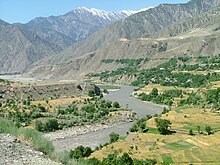Chitral
Chitral (Urdu: ضلع چترال) is the largest district in the Khyber-Pakhtunkhwa province of Pakistan, covering an area of 14,850 km². It is the northernmost district of Pakistan. It shares a border with Gilgit-Baltistan to the east, with Kunar, Badakshan and Nuristanprovinces of Afghanistan to the north and west, and with the Khyber-Pakhtunkhwa districts of Swat and Dir to the south. A narrow strip of Wakhan Corridor separates Chitral from Tajikistan in the north.
Chitral History
This is a brief overview of the history of Chitral. Its purpose is to acquaint the visitors of this Site with the historical background of the country.
Chitral Fort
Not much is known about the early history of Chitral and its neighbouring areas. The country has been divided between two ethnic groups since long. The people living in the upper part being called Khow and the one living in the lower part Kalash. The two people shared a lot of common cultural traits, yet they have been distinct people since long. On the basis of this ethnic division, the country has most of the time remained divided into two principalities. Old traditions have saved names of some local rulers like Sumalik and Bahman in the upper part, and Bulesing and Raja Wai in the lower part. These were probably local chiefs, with small areas under them.
Great neighbouring powers like China and Tibet are believed to have conquered this country in the distant past. During the first half of the 16th Century, the Chaghtai Khanate of Kashghar made inroads to Chitral, and the area was annexed to Kashghar. Chaghtais ruled Chitral through their own governors for quite sometimes. Chitral remained under the influence of Kashghar even after the end of the Chaghatai Kingdom. Eluths (Kalmaks) and then Chinese kept meddling in the affairs of Chitral during their presence in the Tarim Basin (Kashghar and Yarkand). Long association with the kingdom of Kashghar made the country being called Qashqar by the people to the south of it.
The earliest ruling dynasty, about which we know something, is called RAEES. This dynasty made the present town of Chitrar their capital. The town, and after it, the whole country was called Chitral by the outsiders. A long succession of rulers are named in this dynasty, but only few of them, like Shah Nasir, Shah Mahmud and Shah Abdul Qadir have been historically established. The rulers of this line are said to be the vessels of some foreign country (most probably of Badakhshan).
Sometimes during the early Eighteenth Century, a local family of Mulkhow valley increased its power rapidly, and finally supplanted the RAEES dynasty. Muhtaram Shah (Katur-I), the head of the family was installed as the Mehtar (ruler). It is believed that during the Raees reign, the country had witnessed much territorial expansion, bringing the whole of the present Chitral under the Raees rule. Some parts of the present Gilgit-Baltistan province were also annexed by these rulers, making Chitral the capital of a small kingdom. The whole region was inherited by the new ruling family, but they partitioned the country into two principalities. Muhtaram Shah’s successors occupied the lower part of Chitral, while Khushwaqt’s offspings controlled Mastuj and Trans-Shandur territories. However it was not a peaceful settlement, as both families continuously made claim to each other’s territories. The dispute was finally settled in favour of the Katurs towards the ends of the nineteenth Century, when Aman ul Mulk became the overlord of the whole country, from Punial in the Gilgit Valley to Narsat in the Kunar country.
Under Aman ul Mulk, the kingdom was at its zenith. But at the same time it began losing its independence. The Great Mehtar, as he was called, had to accept the suzerainty of the Maharaja of Kashmir, under threat from the powerful Kingdom of Kabul. As Kashmir was part of the British Indian Empire, Chitral automatically came under the influence of the British.
After the death of Amanul Mulk in 1892, the country witnessed a long war of succession in which five sons of Aman ul Mul lost their lives. Such struggles for the thrown were not new for ruling family, true to its claim of Mughal descend. But this time, the war proved too much for the small kingdom. Many actors jumped in the arena of war, including the British and the Jandul Chief Umara Khan. The British Agent George Robertson was besieged in the Chitral Fort with his garrison for 47 days. They were relieved by two forces, one marching from Nowshehra, and the other from Gilgit. During the siege, the British Agent had installed Price Shuja ul Mulk as the new Mehtar, who was to rule the country for the next forty years.
The country remained under the British control till 1947. The British controlled the external affairs and defense of the country, and the ruler had autonomy for internal administration. Chitral opted to join Pakistan after partition of India. In principle, the State of Pakistan had to play the same role as the British did. However after the partition, the Mehtar rapidly lost his powers to representatives of Pakistan, in the end becoming a nominal head. The State of Chitral was merged into the North West Frontier Province of Pakistan in 1969 as an administrative district.
ADMINISTRATIVE SETUP
Chitral was an autocratic state. The will of the ruler used to be the ultimate law of the land. However a number of traditions and customary laws were strictly adhered to, even the ruler himself generally respecting them. The ruler was the highest court of appeal. Islamic Sharia was also supposed to be the law in many kinds of cases. Qazis in different part of the country, as well as in the capital,
decided cases according to Sharia. Mehtar Shujaul Mulk founded a body, named Judicial Council, which advised him in judicial matters. Mehtar referred cases to this body for investigation and fact finding. Persons well versed in the customary law of the land, were nominated to this body from all over the country.
The country was divided into many provinces. Every province was ruled by a son or some near relative of the Mehtar. Provinces were further divided districts, headed by administrators styled Hakim or Charwelu.
Main functionaries of the state were, Atalique (Defence Minister), Aqsaqal (Minister of Revenue), Baramush (minister of works), Diwan Begi (treasurer). Functionaries with the same nomenclature also worked in the provinces.
The state revenue and finance system worked without a currency. All dues to the state were collected in kind, and the functionaries were also paid in the same way. The revenue system was very complex. Everybody paid something to the state or worked for it, according to his own social status. The upper strata of the society, called Adamzada were exempt from all taxes. These were the people either directly related to the ruling family, or had been raised to the this status by the ruler, in recognition of some valuable service rendered to the ruler. Main responsibility of Adamzada class was to perform military duty.
Below this class were the common subjects, called Yuft. This class paid the bulk of revenue. The class also helped in the defence of the country. Another class was Rayat, which rendered some specified service to the ruler in return for state land, which they work for themselves. The revenue system was not much organized during the early rulers. Shujaul Mulk apart from regularizing existing taxes, levied a tax @ 1/10 on all produce. With this tax, for the first time Adamzadas were brought under the revenue system.
Many other administrative reforms were introduced by Shuja ul Mulk and his successor Muhammad Nasir ul Mulk. The system was abolished and replaced by a new one in 1953, which remained in force till 1969.
Amanul Mulk, 1856-1892
Shujaul Mulk, 1895-1936
Nasirul Mulk, 1936-43
Muzaffarul Mulk, 1943-49
Saifur Rahman, 1949-54
Rulers of Chitral (Katur Dinasty)
Muhtaram Shah Katur-I (Early Eighteenth Century)
SanginAli-II (early to mid-eighteenth Century)
Muhammad Ghulam (Mid-Eighteenth Century)
Shah Muhammad Shafee (Mid-eighteenth Century)
Shah Faramurz of Khushwaqte line.(Mid-eighteenth Century)
Shah Afzal –I(2nd half of Eighteenth Century)
Shah Fazil(2nd half of Eighteenth Century)
Shah Nawaz Khan(2nd half of Eighteenth Century)
Shah Khairullah of the Khushwaqte line (Died 1791-92)
Muhtaram Shah Katur-II (Died 1837)
Shah Afzal-II (1837-1854)
Muhtaram Shah-III (1854-1856)
Amanul Mulk (1856-1892)
Afzalul Mulk (for two months in 1892)
Sher Afzal Khan( one month in 1892)
Nizamul Mulk (1892-95)
Amirul Mulk (two months in 1895)
Shjaul Mulk ( 1895-1936)
Muhammad Nasirul Mulk (1936-43)
Muzaffarul Mulk (1943-1949)
Saifur Rehman (1949-54 )
Saiful Mulk Nasir (1954-69)
Topography and access
Chitral is counted amongst the highest regions of the world, sweeping from 1,094 meters at Arandu to 7,726 meters at Tirichmir, and packing over 40 peaks more than 6,100 meters in height. The terrain of Chitral is very mountainous and Tirich Mir (25,289 feet) the highest peak of the Hindu Kush, rises in the north of the district.Around 4.8 per cent of the land is covered by forest and 76 per cent is mountains and glaciers.
Chitral is connected to the rest of Pakistan by two major road routes, the Lowari Pass (el. 10,230 ft.) from Dir and Shandur Top (elevation 12,200 ft.) from Gilgit. Both routes are closed in winter. The Lowari Tunnel is being constructed under the Lowari Pass.A number of other high passes, including Darkot Pass, Thoi Pass and Zagaran Pass, provide access on foot to Chitral from Gilgit-Baltistan in Ghizer District.
- Arandu Pass, on the border between Pakistan and Afghanistan
- Broghol Pass, on the border between Pakistan and Afghanistan
- Dorah Pass, on the border between Pakistan and Afghanistan
- Darkot Pass, on the border between Chitral and Ghizer
- Shandur Pass, on the border between Chitral and Ghizer Gilgit-Baltistan
- Lowari Pass, on the border between Chitral and upper Dir
- Lowari Tunnel, uncompleted[8]
- Thoi Pass, on the border between Chitral and Yasin Gilgit-Baltistan
- Zagaran Pass, on the border between Chitral and Gilgit-Baltistan
Demographics
The district has a population of about 414,000. The general population is mainly of the Kho people, who speak the Khowar, which is also spoken in parts of Yasin, Gilgit, Dir and Swat. Chitral is also home to the Kalash tribe, who live in Bumburet and two other remote valleys southwest of Chitral town.
Languages
Most of the minority languages are Dardic, including Shina, Kashmiri, Kalasha, Gawar Bati, Dameli, Pashayi, Shina, Kohistani, and Palula.[citation needed]
Iranian languages and Pamir languages spoken by immigrant groups in Chitral include Pushto, Munji, Yidgha, Tajik and Wakhi.[citation needed]The Turkic languages Kyrgyz and Uzbek are also spoken in minority.[citation needed]
Although the predominant language of Chitral is Khowar, more than ten other languages are spoken here. These include Kalasha-mun, Palula, Dameli, Gawar-Bati, Nuristani, Yidgha, Burushaski, Gujar, Wakhi, Uzbeki, Kyrgyz, Dari and Pashto. Since many of these languages have no written form, letters are usually written in Urdu or Pashto.[citation needed]
![30863143[1] 30863143[1]](http://www.hkttreks.com/wp-content/uploads/2017/11/308631431-366x275.jpg)

